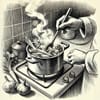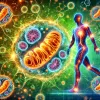Welcome back to our regular feature where we sift through thousands of new, health-related papers, and pick a few to summarize in a practical, simple, and not anxiety-inducing way.
Our main questions on each paper:
- In simple language, what does it say?
- Does it have good evidence?
- Should what it says matter to normal people?
- What simple thing, if anything, could a normal person do to take advantage of this finding?
Okay, away we go. And, as always, we rate each paper for practicality and level of interest, but we are mostly focused on finding ways to simplify findings. And more than anything else, we want to avoid over-optimization, so if a paper is telling you down to the minute how much sunlight to get at dawn, or that you should only drink coffee during eclipses, we are outta there.
This edition's articles and papers:
- Body Recomposition: Can Trained Individuals Build Muscle and Lose Fat At the Same time? https://journals.lww.com/nsca-scj/fulltext/2020/10000/body_recomposition__can_trained_individuals_build.3.aspx?ck_subscriber_id=1918138411
- Dietary patterns and insomnia symptoms: A systematic review and meta-analysis - ScienceDirect https://www.sciencedirect.com/science/article/abs/pii/S1087079224000406?via%3Dihub
- Exposure to Fine Particulate Matter Air Pollution Disrupts Erythrocyte Turnover | Circulation Research https://www.ahajournals.org/doi/10.1161/CIRCRESAHA.124.324411
- Time spent in outdoor light is associated with increased blood pressure, higher hypertension risk, and lower hypotension risk | medRxiv https://www.medrxiv.org/content/10.1101/2024.04.26.24306464v1
Now, here are our takes on the articles and papers:
Paper: Is Body Recomposition Realistic?
Practicality (4/5): 🏃♂️🏃♂️🏃♂️🏃♂️
Interest (4/5): 🏃♂️🏃♂️🏃♂️🏃♂️
Summary
Among the most common fitness objectives is to gain muscle while losing fat. Usually called "body recomposition", this has long been been thought to be mainly an option for beginners or those who are significantly overweight. This study shows that, with appropriate resistance training and nutritional strategies, recreational and even trained athletes can achieve body recomposition. But it requires planning and careful management.
What is the paper's main claim?
- Trained individuals can gain muscle and lose fat at the same time using tailored resistance training and nutrition.
Are the methods and/or data it uses appropriate and convincing?
- The paper compiles various studies, allowing for a comprehensive review, but individual study methodologies might impact reliability.
- Testing body composition changes is complex, and minor inconsistencies between measuring tools might affect accuracy.
What do we know now that we didn't know before, if anything?
- Prior understanding was that only beginners or overweight individuals could recompose their bodies, but evidence shows it is also possible for trained individuals.
What simple and practical thing could a normal person do knowing this?
- By careful management of workout intensity, training routine, and protein intake, it is possible to to do a body recomposition.
Paper: Diet and Insomnia
Practicality (4/5): 🏃♂️🏃♂️🏃♂️🏃♂️
Interest (5/5): 🏃♂️🏃♂️🏃♂️🏃♂️🏃♂️
Summary
The study investigated the connection between what people eat and insomnia. By analyzing the diets of over half a million participants, it revealed that healthier eating patterns are linked to fewer insomnia symptoms. The findings also suggested that the relationship between diet and sleep may be influenced by inflammation in the body.
What is the paper's main claim?
- More nutritious diets are associated with lower chances of experiencing insomnia symptoms.
- The study implies inflammation caused by certain foods might impact sleep quality.
Are the methods and/or data it uses appropriate and convincing?
- The study reviewed 591,223 individuals, providing a robust base for its conclusions.
- By its nature the study can't establish causality, however, only associations.
What do we know now that we didn't know before, if anything?
- The research adds to our understanding by statistically reinforcing the link between healthy eating and reduced insomnia symptoms.
- It identifies the need for further research into how dietary habits may lead to inflammation affecting sleep.
What simple and practical thing could a normal person do knowing this?
- Eat well before bedtime, and eat a more nutritious diet not just for physical health but also potentially to improve sleep quality.
Paper: Air Pollution and the Blood
Practicality (3/5): 🏃♂️🏃♂️🏃♂️
Interest (5/5): 🏃♂️🏃♂️🏃♂️🏃♂️🏃♂️
Summary
Breathing in fine particles from the air (like smoke or dust) can make it harder for the body to get rid of old or damaged red blood cells. The study looked at this process in mice and found that exposure to tiny particles not only increases stress markers on the red blood cells but also tampers with the cells in the spleen responsible for clearing out these cells. While the body tries to adapt by making more clean cells, they are not as effective.
What is the paper's main claim?
- Exposure to fine particulate matter in the air leads to stressed red blood cells and impairs their removal from circulation.
- The spleen's capacity to clear these cells is hindered despite an increase in the cells that are supposed to do the cleaning.
Are the methods and/or data it uses appropriate and convincing?
- The study used real-world relevant levels of air pollutants and checked the blood and spleens of mice for changes.
- Effects are clearly demonstrated, but the study was conducted on mice, so it's not guaranteed that humans are affected in the same way — more research is needed on human subjects.
What do we know now that we didn't know before, if anything?
- Dirty air doesn't just put a strain on red blood cells; it also messes with the spleen's ability to remove these stressed cells.
- The findings add a piece to the puzzle of how air pollution contributes to heart disease, showing that the cleanup process of blood cells is disrupted.
What simple and practical thing could a normal person do knowing this?
- While you can't always control the air you breathe outdoors, being aware of air quality forecasts can help you minimize exposure on bad days, potentially reducing the risk for your heart.
Paper: Light and Blood Pressure
Practicality (3/5): 🏃♂️🏃♂️🏃♂️
Interest (3/5): 🏃♂️🏃♂️🏃♂️🏃♂️
Summary
The study explored the relationship between outdoor light exposure and blood pressure, finding, very surprisingly, that more time spent in sunlight may increase the risk of high blood pressure and decrease the risk of low blood pressure. It also suggested that the impact of light exposure on blood pressure might be influenced by factors such as aging, inflammation, and body mass. The research calls for further studies as its conclusions are contrary to the general view that outdoor activity in sunlight reduces blood pressure.
What is the paper's main claim?
- The paper suggests that more exposure to outdoor light could potentially raise the risk of high blood pressure and lower the risk of low blood pressure.
- The effects, however, of light on blood pressure may be partly due to changes in one’s biological age, immune system activity, and weight.
Are the methods and/or data it uses appropriate and convincing?
- Large sample size and long follow-up period strengthen the reliability of the findings; the use of questionnaires and health records to track exposure and blood pressure incidences is standard practice.
- The study's statistical methods, such as Cox regression, provide a reasonable approach to understanding risk factors, but confounding variables might still affect the outcomes.
What do we know now that we didn't know before, if anything?
- The results challenge prior beliefs by suggesting sunlight exposure might increase blood pressure, which is a novel finding
- The result is surprising and preliminary, even if it is being spread widely. It requires much confirmatory work.
Back next week with thoughtful and simplifying takes on papers getting attention. And if you see anything you want us to look at, let us know.





